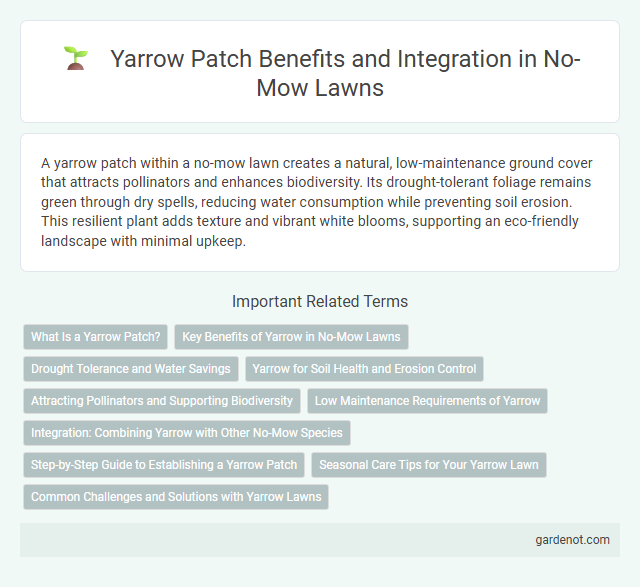A yarrow patch within a no-mow lawn creates a natural, low-maintenance ground cover that attracts pollinators and enhances biodiversity. Its drought-tolerant foliage remains green through dry spells, reducing water consumption while preventing soil erosion. This resilient plant adds texture and vibrant white blooms, supporting an eco-friendly landscape with minimal upkeep.
What Is a Yarrow Patch?
A yarrow patch is a dense grouping of Achillea millefolium, a hardy perennial flowering plant known for its feathery leaves and clusters of small, white to pink blossoms. This low-maintenance plant thrives in no-mow lawns, contributing to soil stabilization and attracting beneficial pollinators such as bees and butterflies. Yarrow patches are drought-tolerant and naturally resistant to pests, making them an eco-friendly choice for sustainable landscaping.
Key Benefits of Yarrow in No-Mow Lawns
Yarrow in no-mow lawns enhances soil health by fixing nitrogen and improving moisture retention, reducing the need for fertilizers and frequent watering. Its deep roots prevent soil erosion while promoting aeration and microbial activity, supporting a resilient lawn ecosystem. The drought-tolerant, low-maintenance nature of yarrow also creates a visually appealing, fragrant ground cover that attracts pollinators like bees and butterflies.
Drought Tolerance and Water Savings
Yarrow patch thrives in no-mow lawns due to its exceptional drought tolerance, requiring minimal irrigation once established. Its deep root system efficiently conserves water, making it an ideal choice for sustainable landscaping in arid regions. Incorporating yarrow reduces overall water usage by up to 50% compared to traditional grass lawns.
Yarrow for Soil Health and Erosion Control
Yarrow (Achillea millefolium) thrives in no-mow lawns, enhancing soil health by improving microbial activity and nutrient cycling. Its deep root system stabilizes soil, significantly reducing erosion on slopes and compacted areas. Rich in essential oils, yarrow also promotes water retention, making it an ideal natural solution for sustainable lawn management.
Attracting Pollinators and Supporting Biodiversity
Yarrow patches in no-mow lawns serve as vital habitats that attract diverse pollinators, including bees, butterflies, and beneficial insects, enhancing local biodiversity. Their dense flower clusters provide abundant nectar and pollen resources throughout the growing season, supporting the ecological food web. Incorporating yarrow into landscaping promotes resilient ecosystems and encourages natural pest control by fostering populations of predatory insects.
Low Maintenance Requirements of Yarrow
Yarrow patches require minimal maintenance, thriving in poor soil conditions with little water and infrequent mowing. Their drought tolerance and resistance to pests reduce the need for fertilizers and pesticides. This makes yarrow an ideal choice for no-mow lawns seeking sustainability and low upkeep.
Integration: Combining Yarrow with Other No-Mow Species
Integrating yarrow (Achillea millefolium) with other no-mow species such as clover, sedum, and native grasses creates a resilient, low-maintenance lawn that supports pollinators and enhances soil health. Yarrow's deep root system improves drought tolerance and aeration while complementing the nitrogen-fixing properties of clover and the ground-cover benefits of sedum. This combination reduces the need for irrigation and fertilizers, promoting sustainable landscape management and biodiversity in residential and commercial no-mow lawns.
Step-by-Step Guide to Establishing a Yarrow Patch
Prepare the soil by clearing existing grass and loosening the earth to ensure proper root growth for yarrow. Sow yarrow seeds evenly over the area during spring or early autumn for optimal germination. Water the patch consistently until seedlings establish, then allow the plants to thrive with minimal mowing for a low-maintenance, drought-tolerant lawn alternative.
Seasonal Care Tips for Your Yarrow Lawn
Yarrow lawns thrive with minimal mowing, but seasonal care enhances their health and appearance. In spring, thin out old growth and apply a balanced fertilizer to support vigorous growth, while in summer, water deeply yet infrequently to prevent stress. During fall, trim the plants back to promote fresh shoots in spring and mulch to protect roots from winter cold.
Common Challenges and Solutions with Yarrow Lawns
Yarrow lawns often face challenges such as drought sensitivity, invasive spreading, and uneven growth patterns. To manage these issues, maintaining well-drained soil and implementing regular trimming prevents overgrowth and preserves aesthetic appeal. Incorporating mulch during dry periods enhances moisture retention and controls weed competition effectively.
Yarrow patch Infographic

 gardenot.com
gardenot.com